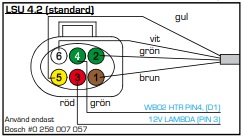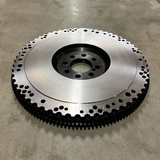Wideband Lambda - Information
Here you get an overview of how a lambda sensor works.
The information is divided into the following categories:
- What does a lambda sensor do?
- What is a wideband lambda?
- Choosing a lambda
- What is the difference between Bosch LSU 4.2 and 4.9?
- Installation of lambda sensor.
- Lambda vs AFR
- Accessories
- Compare lambda sensors
1 ▼
What does a lambda sensor do?
A lambda sensor measures the fuel mixture (the amount of oxygen O2 in the exhaust gases). Usually, a so-called narrowband lambda sensor is installed as standard. This regulates between high and low (above or below lambda 1). In this way, the engine knows whether more or less fuel should be injected in relation to the amount of air.
Stoichiometric mixture = "Optimal combustion" = lambda 1 = AFR 14.7
2 ▼
What is a wideband lambda?
A wideband lambda, unlike a narrowband lambda, can measure the exact fuel mixture within a range, not just high or low. Often from lambda 0.65 to perhaps 1.7. Since you can get accurate measurement values of the fuel mixture, these are often used during mapping/tuning of the ECU.
3 ▼
Choosing a lambda
When choosing a lambda sensor, it is important to ensure that it fits your specific control system. Most control systems can handle both LSU 4.9 and LSU 4.2, although the connections differ. Many gauges only support either 4.9 or 4.2, so it is not possible to use both lambda sensors in all units.
LSU 4.9
This wideband lambda measures slightly better around lambda 1. So if you mostly use the car on the street, this can be a favorable choice.
LSU 4.2
This wideband lambda measures better in the richer range, below lambda 1 down to 0.7-0.6. So this sensor may be the better choice if you have a pure racing car like drag racing, drifting, or circuit racing.
4 ▼
What is the difference between Bosch LSU 4.2 and 4.9?
The differences between Bosch LSU 4.2 and 4.9 are cable length, sensor type, connector, and wiring.
Wiring LSU 4.2

Wiring LSU 4.9

5 ▼
Installation of lambda sensor
Installation of lambda sensor:
- V-motor should preferably use one sensor per side. If not, install the sensor on either side.
- With a turbo engine, you should have the lambda sensor 40-60 cm away from the turbo.
- If you are running without a turbo, you can install the lambda sensor in the collector that connects the exhaust manifolds.
- With an aftermarket control system, it is important to choose the correct lambda sensor in the settings.
- It is also very important not to mount the lambda sensor with the sensor pointing upwards, as this poses a significant risk of moisture and dirt accumulating in the sensor, which will lead to premature failure since a lambda sensor is sensitive to moisture.

6 ▼
Lambda vs AFR
The measurement value from a lambda sensor is expressed in the units AFR or lambda. This varies depending on the gauge but can also be selectable in some cases.
Stoichiometric combustion is the perfect amount of air required to combust a certain type of fuel. The result is minimal unburned fuel and gases.
AFR
The stoichiometric mixture for different fuels is as follows, where gasoline, for example, should have 14.7 parts air to 1 part fuel for a stoichiometric mixture. A list for this can be found here.
Air to Fuel Ratios:
Gasoline - 14.7:1
E85 - 9.76:1
E100 - 8.8:1
Methanol - 6.46:1
Diesel - 14.5:1
Lambda value works differently. There, the stoichiometric mixture for all fuels is Lambda 1. A lower air ratio results in a richer fuel mixture. In other words, a lower Lambda / AFR value indicates a richer fuel mixture. Conversely, a higher Lambda / AFR value indicates a leaner fuel mixture.
7 ▼
Accessories
Lambda Nut
Used for welding the connection of the lambda sensor into your system yourself.
Bosch LSU 4.2 and 4.9 have an M18x1.5 thread but are also compatible with other sensors that have the same thread specification.
Lambda Plug
Used when you want to seal the system and remove the lambda sensor.
Connector
The Bosch LSU 4.2 and 4.9 sensors have a 6-pin connector. The 4.9 has a slightly smaller connector than the 4.2.
Heat Shield Sleeve
A heat shield sleeve is used to protect hoses and wiring from radiant heat, oils, and other substances that could damage the lambda sensor.
▼
▼
-
Engine management / Electric
- Engine control system: The various parts available
- Ignition System Information
- Install motor control
- Pressure sensor - Information
- Temperature sensor - Information
- Buttons - Switches - Information
- Connectors - Information
- Cooling fan car - Information
- Exhaust gas temperature sensor - EGT Sensor
- Lambda sensor - Wide band lambda
- Relay - Information
- Relay box - Fuse central
- CAN protocol - Canbus
- Ethanol sensor - Information
- Gauges and Dash
- Trigger sensor information
- Dimensioning of cable [and fuse size]
- Distributor Problems (And Solution)
- How does an Ignition Coil work?












































